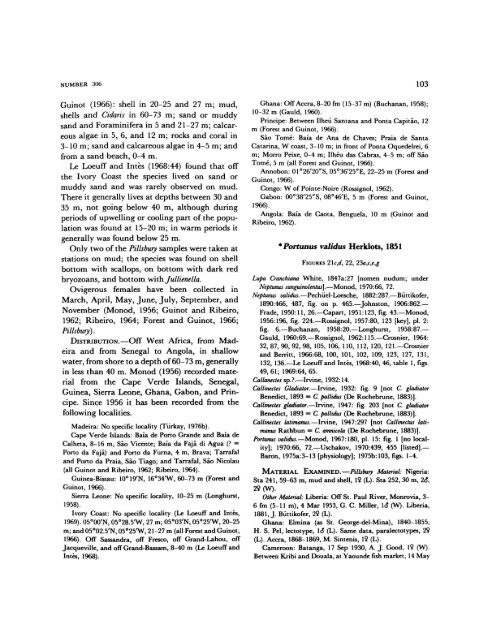West African Brachyuran Crabs - Smithsonian Institution Libraries
West African Brachyuran Crabs - Smithsonian Institution Libraries
West African Brachyuran Crabs - Smithsonian Institution Libraries
Create successful ePaper yourself
Turn your PDF publications into a flip-book with our unique Google optimized e-Paper software.
NUMBER 306 103<br />
Guinot (1966): shell in 20-25 and 27 m; mud,<br />
shells and Cidaris in 60-73 m; sand or muddy<br />
sand and Foraminifera in 5 and 21-27 m; calcareous<br />
algae in 5, 6, and 12 m; rocks and coral in<br />
3-10 m; sand and calcareous algae in 4-5 m; and<br />
from a sand beach, 0-4 m.<br />
Le Loeuff and Intes (1968:44) found that off<br />
the Ivory Coast the species lived on sand or<br />
muddy sand and was rarely observed on mud.<br />
There it generally lives at depths between 30 and<br />
35 m, not going below 40 m, although during<br />
periods of upwelling or cooling part of the population<br />
was found at 15-20 m; in warm periods it<br />
generally was found below 25 m.<br />
Only two of the Pillsbury samples were taken at<br />
stations on mud; the species was found on shell<br />
bottom with scallops, on bottom with dark red<br />
bryozoans, and bottom with Jullienella.<br />
Ovigerous females have been collected in<br />
March, April, May, June, July, September, and<br />
November (Monod, 1956; Guinot and Ribeiro,<br />
1962; Ribeiro, 1964; Forest and Guinot, 1966;<br />
Pillsbury).<br />
DISTRIBUTION.—Off <strong>West</strong> Africa, from Madeira<br />
and from Senegal to Angola, in shallow<br />
water, from shore to a depth of 60-73 m, generally<br />
in less than 40 m. Monod (1956) recorded material<br />
from the Cape Verde Islands, Senegal,<br />
Guinea, Sierra Leone, Ghana, Gabon, and Principe.<br />
Since 1956 it has been recorded from the<br />
following localities.<br />
Madeira: No specific locality (Tiirkay, 1976b).<br />
Cape Verde Islands: Baia de Porto Grande and Baia de<br />
Calheta, 8-16 m, Sao Vicente; Baia da Faja di Agua (? =<br />
Porto da Faja) and Porto da Furna, 4 m, Brava; Tarrafal<br />
and Porto da Praia, Sao Tiago; and Tarrafal, Sao Nicolau<br />
(all Guinot and Ribeiro, 1962; Ribeiro, 1964).<br />
Guinea-Bissau: 10°19'N, 16°34'W, 60-73 m (Forest and<br />
Guinot, 1966).<br />
Sierra Leone: No specific locality, 10-25 m (Longhurst,<br />
1958).<br />
Ivory Coast: No specific locality (Le Loeuff and Intes,<br />
1969). 05°00'N, 05°28.5'W, 27 m; 05°03'N, 05°25"W, 20-25<br />
m; and 05°02.5'N, 05°25'W, 21-27 m (all Forest and Guinot,<br />
1966). Off Sassandra, off Fresco, off Grand-Lahou, off<br />
Jacqueville, and off Grand-Bassam, 8-40 m (Le Loeuff and<br />
Intes, 1968).<br />
Ghana: Off Accra, 8-20 fm (15-37 m) (Buchanan, 1958);<br />
10-32 m (Gauld, 1960).<br />
Principe: Between Uheu Santana and Ponta Capitao, 12<br />
m (Forest and Guinot, 1966).<br />
Sao Tome: Baia de Ana de Chaves; Praia de Santa<br />
Catarina, W coast, 3-10 m; in front of Ponta Oquedelrei, 6<br />
m; Morro Peixe, 0-4 m; Ilheu das Cabras, 4-5 m; off Sao<br />
Tome, 5 m (all Forest and Guinot, 1966).<br />
Annobon: 01°26'20"S, 05°36'25"E, 22-25 m (Forest and<br />
Guinot, 1966).<br />
Congo: W of Pointe-Noire (Rossignol, 1962).<br />
Gabon: 00°38'25"S, 08°46'E, 5 m (Forest and Guinot,<br />
1966).<br />
Angola: Baia de Caota, Benguela, 10 m (Guinot and<br />
Ribeiro, 1962).<br />
*Portunus validus Herklots, 1851<br />
FIGURES 2lc,d, 22, 23a,c,e,g<br />
Lupa Cranchiana White, 1847a:27 [nomen nudum; under<br />
Neptunus sanguinolentus].—Monod, 1970:66, 72.<br />
Neptunus validus.—Pechiiel-Loesche, 1882:287.—Bvittikofer,<br />
1890:466, 487, fig. on p. 465.—Johnston, 1906:862.—<br />
Frade, 1950:11, 26.—Capart, 1951:123, fig. 43.—Monod,<br />
1956:1%, fig. 224.—Rossignol, 1957:80, 123 [key], pi. 2:<br />
fig. 6.—Buchanan, 1958:20.—Longhurst, 1958:87.—<br />
Gauld, 1960:69.—Rossignol, 1962:115.—Crosnier, 1964:<br />
32, 87, 90, 92, 98, 105, 106, 110, 112, 120, 121.—Crosnier<br />
and Berritt, 1966:68, 100, 101, 102, 109, 123, 127, 131,<br />
132, 136.—Le Loeuff and Intes, 1968:40, 46, table 1, figs.<br />
49,61; 1969:64, 65.<br />
Callanectes sp.?.—Irvine, 1932:14.<br />
Callinectes Gladiator.—Irvine, 1932: fig. 9 [not C. gladiator<br />
Benedict, 1893 = C. pallidus (De Rochebrune, 1883)].<br />
Callinectes gladiator.—Irvine, 1947: fig. 203 [not C. gladiator<br />
Benedict, 1893 = C. pallidus (De Rochebrune, 1883)].<br />
Callinectes latimanus.—Irvine, 1947:297 [not Callineclus latimanus<br />
Rathbun — C. ammcola (De Rochebrune, 1883)].<br />
Portunus validus.—Monod, 1967:180, pi. 15: fig. 1 [no locality];<br />
1970:66, 72.—Uschakov, 1970:439, 455 [listed].—<br />
Baron, 1975a:3-13 [physiology]; 1975b: 103, figs. 1-4.<br />
MATERIAL EXAMINED.—Pillsbury Material: Nigeria:<br />
Sta 241, 59-63 m, mud and shell, 19 (L). Sta 252, 30 m, 26,<br />
2$(W).<br />
Other Material: Liberia: Off St. Paul River, Monrovia, 3-<br />
6 fm (5-11 m), 4 Mar 1953, G. C. Miller, lcj (W). Liberia,<br />
1881, J. Biittikofer, 2$ (L).<br />
Ghana: Elmina (as St. George-del-Mina), 1840-1855,<br />
H. S. Pel, lectotype, l

















